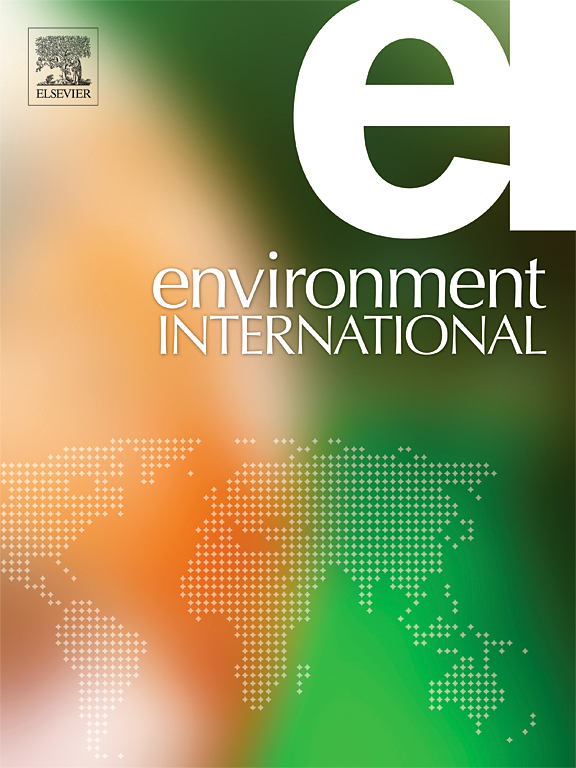Source-specific nitrate and nitrite intake and association with colorectal cancer in the Danish Diet, Cancer and Health Cohort
IF 10.3
1区 环境科学与生态学
Q1 ENVIRONMENTAL SCIENCES
引用次数: 0
Abstract
Introduction
Nitrate and nitrite, present in food and drinking water, may contribute to colorectal cancer (CRC) through the formation of carcinogenic N-nitroso compounds (NOCs). This study examined source-specific associations with CRC and subtypes, considering potential dietary and lifestyle factors that influence NOC formation.
Methods
In the Danish Diet, Cancer, and Health Cohort (N=54,610), nitrate/nitrite intake was estimated from comprehensive databases and national monitoring data. Over 27 years, 2245 CRC cases (1508 colon and 737 rectal) were identified via the Danish Cancer Registry. Cox proportional hazards models adjusted for sociodemographic, diet, and lifestyle factors were used to examine associations, with stratified analyses by sex and factors influencing NOC formation.
Results
No associations were found between nitrate/nitrite intakes from plant, naturally-occurring animal sources, or additive-permitted meat sources and CRC. However, higher nitrate intake from tap water (mg/d) was associated with a higher rate of distal colon cancer [HRQ5vQ1 (95% CI); 1.48 (1.11, 1.97)], though not CRC overall. A nitrate concentration in tap water ≥9.25 mg/L was linked to a higher colon cancer rate [HR 1.52 (1.11, 2.07)] compared to <1.27 mg/L. This association appeared stronger in individuals with risk-promoting factors (smoking and high red meat intake) and weaker among those with a high intake of NOC inhibiting factors (vitamin C, vitamin E, folate, and flavonoids).
Conclusion
Nitrate/nitrite intakes from food sources were not associated with rate of CRC in the cohort, but tap water nitrate, at higher intake levels and at concentrations over ≥9.25 mg/L were linked to higher rates of distal colon and colon cancer, respectively.


丹麦饮食、癌症和健康队列中特定来源的硝酸盐和亚硝酸盐摄入量与结直肠癌的关系
食物和饮用水中存在的硝酸盐和亚硝酸盐可能通过形成致癌的n -亚硝基化合物(NOCs)而导致结直肠癌(CRC)。本研究考察了来源特异性与结直肠癌及其亚型的关联,并考虑了影响结直肠癌形成的潜在饮食和生活方式因素。方法在丹麦饮食、癌症和健康队列(n = 54,610)中,从综合数据库和国家监测数据中估计硝酸盐/亚硝酸盐摄入量。在27 年的时间里,通过国家健康登记处发现了2245例CRC病例(1508例结肠和737例直肠)。采用Cox比例风险模型对社会人口学、饮食和生活方式因素进行校正,并按性别和影响NOC形成的因素进行分层分析。结果未发现来自植物、天然动物来源或允许添加的肉类来源的硝酸盐/亚硝酸盐摄入量与CRC之间存在关联。然而,从自来水中摄入更高的硝酸盐(mg/d)与更高的远端结肠癌发病率相关[HRQ5vQ1(95 % CI);1.48(1.11, 1.97)],但总体上不是。自来水中硝酸盐浓度≥9.25 mg/L与结肠癌发病率较高相关[HR 1.52(1.11, 2.07)],而自来水中硝酸盐浓度为1.27 mg/L。这种关联在有风险促进因素(吸烟和大量摄入红肉)的个体中表现得更强,而在有大量摄入NOC抑制因素(维生素C、维生素E、叶酸和类黄酮)的个体中表现得更弱。结论食物来源的硝酸盐/亚硝酸盐摄入量与结直肠癌发病率无关,但自来水硝酸盐摄入量较高和浓度超过≥9.25 mg/L分别与远端结肠癌和结肠癌发病率升高有关
本文章由计算机程序翻译,如有差异,请以英文原文为准。
求助全文
约1分钟内获得全文
求助全文
来源期刊

Environment International
环境科学-环境科学
CiteScore
21.90
自引率
3.40%
发文量
734
审稿时长
2.8 months
期刊介绍:
Environmental Health publishes manuscripts focusing on critical aspects of environmental and occupational medicine, including studies in toxicology and epidemiology, to illuminate the human health implications of exposure to environmental hazards. The journal adopts an open-access model and practices open peer review.
It caters to scientists and practitioners across all environmental science domains, directly or indirectly impacting human health and well-being. With a commitment to enhancing the prevention of environmentally-related health risks, Environmental Health serves as a public health journal for the community and scientists engaged in matters of public health significance concerning the environment.
 求助内容:
求助内容: 应助结果提醒方式:
应助结果提醒方式:


